7 Examples of Low Volume Keywords That Generate a Ton of Traffic
In the recent post Keyword Research as We Know It Is Dead, I discussed how pages targeting long-tail keywords with low volume can get surprisingly large amounts of search traffic. We’re back to look at some more examples of how this happens.
The examples in this post come from a wide variety of industries including enterprise software, insurance, banking, and financial services. Here’s the list. If you’re impatient, click on any link to go to that section.

3M
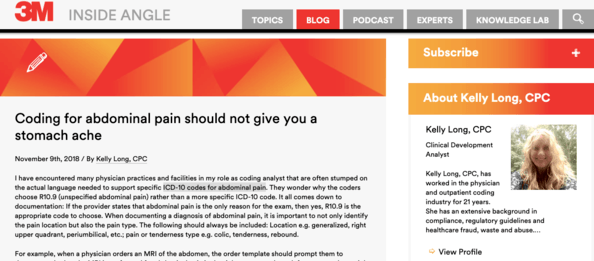
Our first example comes from Inside Angle 3M Health Information Systems, a blog which has consistently ranked high among its peer health IT blogs. Although not immediately evident from the title, the first sentence reveals this post is about ICD 10 codes for abdominal pain.
Keywords and Traffic
Two thousand monthly visits may not sound like much, but given the nature of the topic, it’s quite impressive. After all, how many people do you know that are interested in ICD 10 codes, let alone those for abdominal pain?
The post ranks for a surprising 297 keyword phrases in total, and that figure continues to rise.
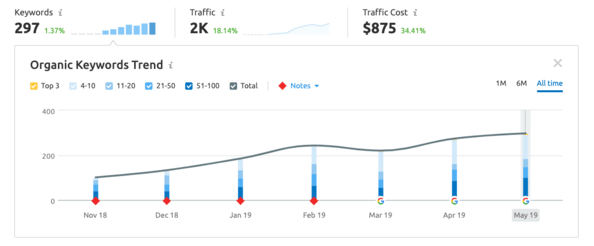
Organic Traffic Sources
A lot of search terms contribute to this post’s traffic success. While a little over five percent of search engine traffic comes from the search term “abdominal pain icd 10” the other 296 keywords account for 95% of monthly traffic.
Although not visible in the screenshot, the majority of search terms for which this post ranks are long-tail keywords with low monthly volume.
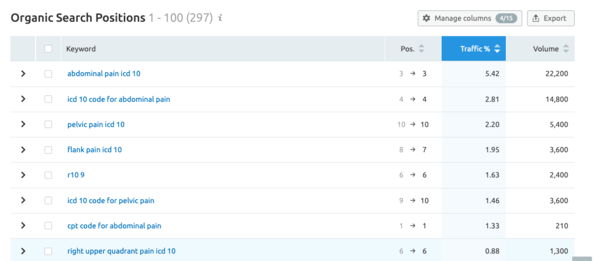
Qualitative Content Analysis
From a content quality perspective, this blog post ranks above average. While other pages in the top 20 search results have higher content scores, the highest being 21, it still sits at a comfortable point.
Given the current condition of the post, it wouldn’t take much to boost the content score up to the recommended target of 17. Since this page currently ranks #8, this would be a wise strategy to protect and improve its position in the SERP. This blog doesn’t appear to employ any links within the content, which is another factor worth considering.

Aetna

This next example, from insurance giant Aetna, targets the topic “infertility treatment insurance coverage.” Now, the title doesn’t use that main keyword phrase and it’s not found anywhere in the content. However, reading the article reveals that the questions answered within are primarily related to that topic.
As it turns out, they also rank #2 for that search term.
Keywords and Traffic

Since it was published last year, this post has seen the number of keywords for which it ranks increase tenfold. During the first month it ranked for around 100 keywords, but over time it has increase to nearly 1,300.
The monthly traffic this post receives has seen a similar increase. But where is it getting all this traffic?
Organic Traffic Sources

Individually, the 1,267 keywords account for little traffic. The search volume on most of these long-tail keywords is negligible. But add them all up and it’s another story.
Qualitative Content Analysis
There’s good news and bad news. Aetna’s post ranks #2; it’s higher than its insurance company counterparts and is comparatively more in-depth. In short, insurance companies aren’t addressing this topic comprehensively.
However, there’s stiff competition in the search engine results page from other actors including a fertility association and a government organization. Their pages, with content scores ranging from the high 30’s up to 50, address this topic with greater detail than Aetna’s post.
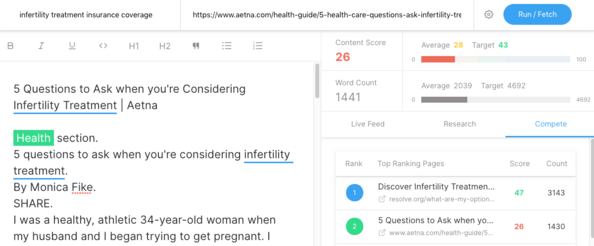
The question is, how long can the good times roll? Should other insurance companies decide to target this topic in a more thorough manner, their fortunes could quickly reverse.
American Express

Nearly eight years ago, American Express published a post on different ways to promote your business online for free. It continues to perform well, pulling in over 8,000 views monthly. Not bad for a page targeting a search term with a monthly volume of less than a hundred!
Keywords and Traffic
The reason it pulls in so much traffic is that it ranks for 2,606 search terms. Individually, the volume of these long-tail keywords is anemic, but together they provide for a steady flow.

Organic Traffic Sources
There isn’t any one keyword that stands out as the main driver of traffic to this page. There are so many ways to express the desire to find free online promotional opportunities. That’s exactly what we’re seeing here.

Qualitative Content Analysis
How times have changed! In 2011, a 600-word post was considered long, but not in 2019. American Express has been fortunate to ride the wave for so long, there’s a storm brewing in this SERP.

Other contenders in the first page or two of the SERP are producing far more authoritative content, with content scores ranging anywhere from 30 all the way to 52. The post itself is well written and concise, but it’s just not thorough enough. Plus, there are no internal links to other relevant pieces of content.
Continuing with the same approach one could easily turn this post into a piece of expert content.
E*TRADE
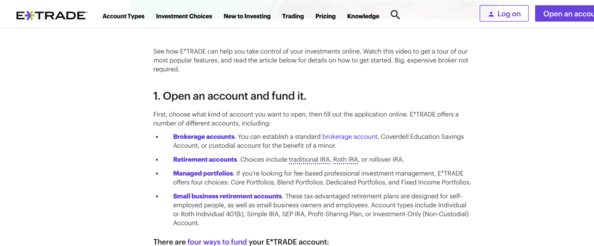
Recently, E*TRADE published a page on how to use its platform. Search volume for the target keyword “how to use etrade” is only a couple of hundred, yet this page receives a few thousands visits each month.
Keywords and Traffic
As in our previous examples, this page ranks for a lot of search terms, resulting in a decent amount of monthly traffic. Since publication, the number of keywords for which this page ranks has risen by 50%.
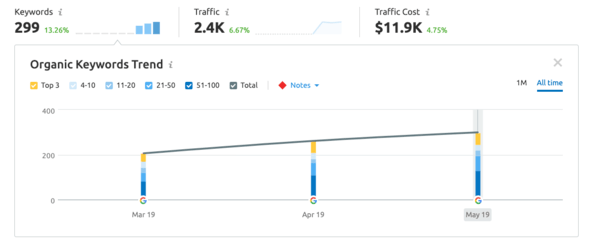
Organic Traffic Sources
Again, there’s no one keyword that is responsible for driving traffic to this page. It’s the cumulative effect of all those long-tail queries that make the difference.

Qualitative Content Analysis
Although the company’s page occupies the #1 position in the SERP for this search term, many other organizations are creating far more comprehensive content. This is evident in both its content score and word count.

To their credit, they’ve done a wonderful job at linking to other content on their site, providing next steps for visitors to take.
GEICO

Surprisingly, it’s a small audience that searches the internet to discover whether car insurance covers rental cars. Yet, GEICO create a post targeting a long-tail keyword with monthly search volume in the hundreds into a post that generates thousands of visits a month.
Keywords and Traffic
The page gets over 6,000 visits each month because it ranks for over 1,000 relevant keywords. Interestingly, although the traffic has remained relatively consistent, the number of ranking keywords has fluctuated significantly during certain periods.
One other thing to note. Running ads on Google targeting this term is ridiculously expensive, which is why the traffic cost value is so high in this case.
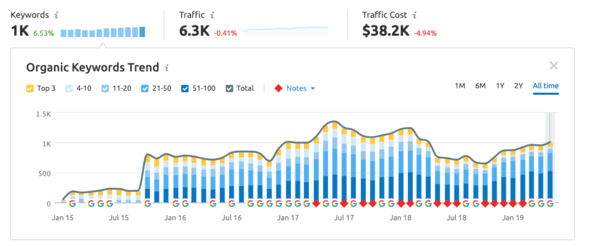
Organic Traffic Sources
Once more, there’s no one keyword that is the big contributor to traffic. But together, those 1,012 ranking search queries result in a good deal of traffic.

Qualitative Content Analysis
With a content score of 23, the quality of this content is below the average of 29. Although they rank #1 for this term, Progressive (at #3) and other SERP competitors are publishing content that is far more in-depth. Content scores for these pages range from 32 to 54, which is a far cry from 23.

In case like this, where you’re #1 despite having inferior content, improving the blog post is a good defensive manoeuvre. Also a good idea, get a MarketMuse Topic Report on this topic for more in-depth competitive SEO analysis.
Oracle
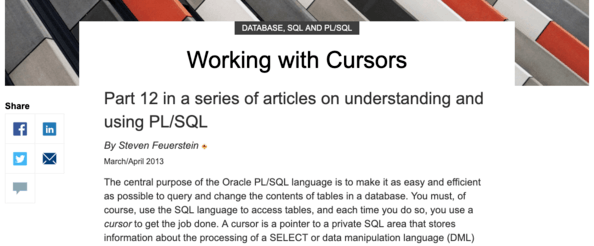
Does anyone actually use the search query “working with cursors”? Apparently, a handful do each month. Yet this post, targeting that term, brings in over 1,700 visits monthly.
How is this possible?
Keywords and Traffic
The page ranks for 97 search queries, although at times it has ranked for nearly 200.

Organic Traffic Sources
As in previous examples, there are a lot of long-tail queries each contributing a small amount of traffic to the page.
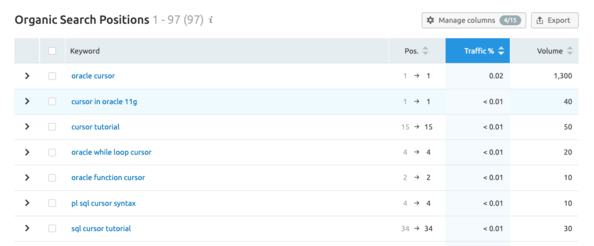
Qualitative Content Analysis
To quote MC Hammer “U can’t touch this.” When it comes to the topic of working with Oracle cursor, this is the most expert content on the web. Its content score of 64 far outshines the average of 29. Not surprising that it ranks #1 for this keyword phrase.

QuickenLoans

Apparently, not many people search Google for “affordable child care options.” Only a couple of dozen searches are performed each month using this keyword phrase. So, you may be surprised to learn that this blog post on Quicken Loans receives nearly 17,000 visits each month!
So where are they getting all the traffic from?
Keywords and Traffic
There are 361 keywords responsible for pulling in 16,800 visits each month with a traffic cost estimated at $76,200. Now we’re talking! Note that over the past few months, the number of ranking keywords has nearly tripled.

Although a hefty amount of traffic comes from the two search terms “day care near me” and “child care near me”, the other 359 search terms are pulling their collective weight.

Qualitative Content Analysis
With a content score of 17, this blog post is below average in terms of content quality. Seeing that it ranks #7 in the search results for its target keyword, there’s some work that needs to be done.
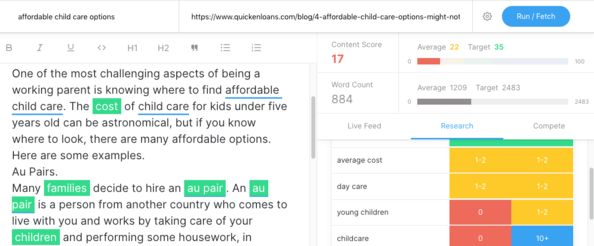
The average content score for the top 20 is 22 with a target of 35. That’s a good target to shoot for, given that the results in positions #1 through #6 have content scores as high as 31.
Final Words
The monthly search volume of the keyword being targeted has little to do with actual traffic realizes. Keyword research tools may tell you that a particular term is not worth the effort, but that’s not true. As this post has demonstrates, low search volume keywords can bring in substantial search traffic. The best way to rank for a large number of search terms is to create content that is thorough and exhaustive.
What you should do now
When you’re ready… here are 3 ways we can help you publish better content, faster:
- Book time with MarketMuse Schedule a live demo with one of our strategists to see how MarketMuse can help your team reach their content goals.
- If you’d like to learn how to create better content faster, visit our blog. It’s full of resources to help scale content.
- If you know another marketer who’d enjoy reading this page, share it with them via email, LinkedIn, Twitter, or Facebook.
Stephen leads the content strategy blog for MarketMuse, an AI-powered Content Intelligence and Strategy Platform. You can connect with him on social or his personal blog.